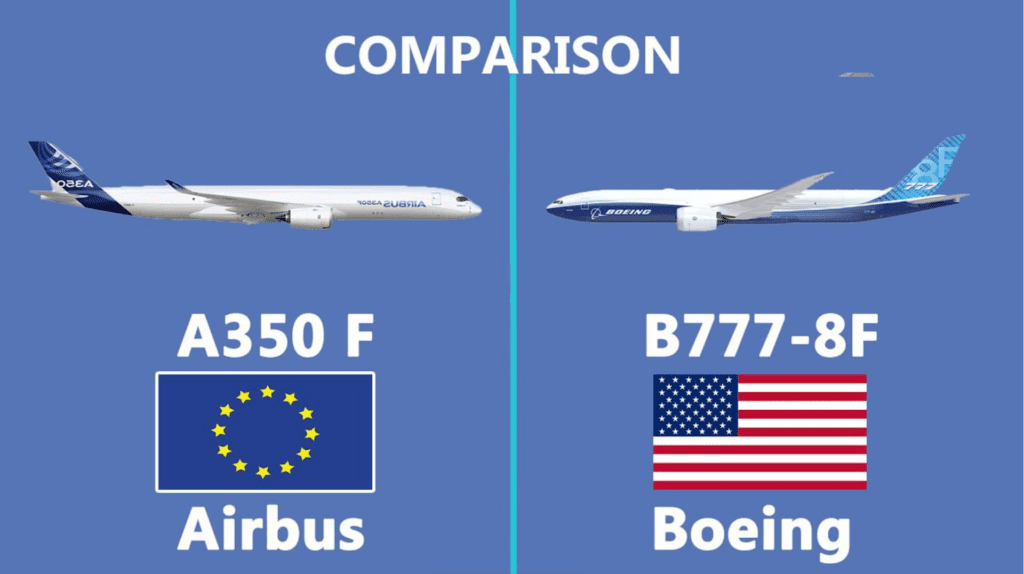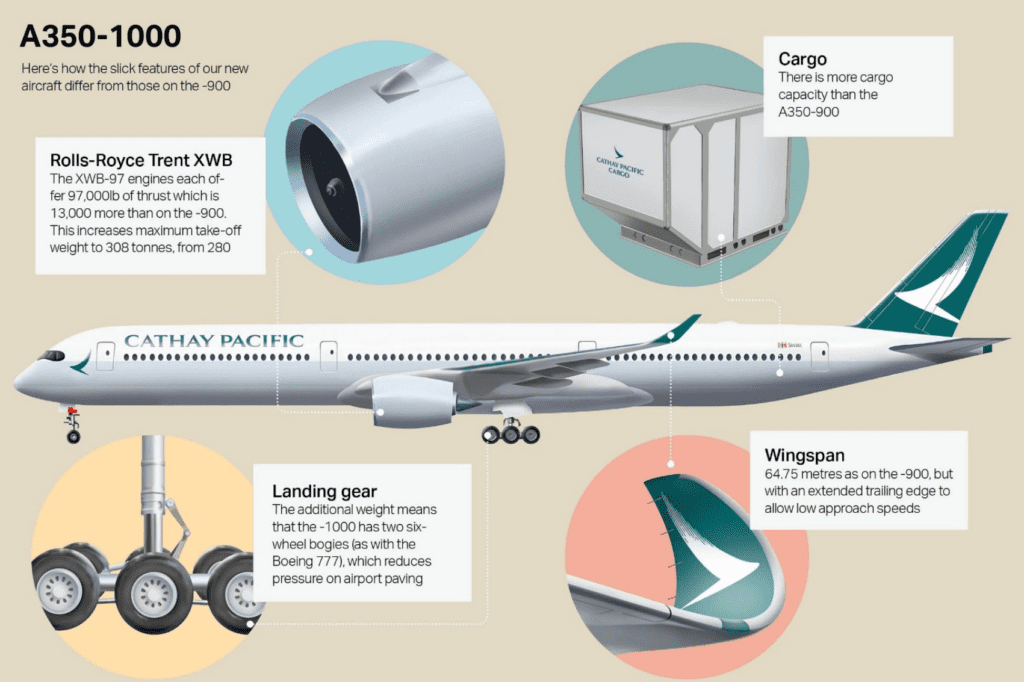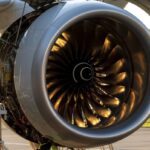
The technical comparison between the Airbus A350 and Boeing 777 highlights the advancements and differences in design, performance, and operational efficiency of two of the most prominent long-haul aircraft in commercial aviation. The A350, developed as a response to the evolving demands of airlines for fuel efficiency and sustainability, incorporates cutting-edge technologies such as composite materials, advanced aerodynamics, and innovative engines, making it a benchmark for modern aircraft design.
In contrast, the Boeing 777, particularly its latest iteration, the 777X, maintains a more traditional design philosophy but integrates notable enhancements in passenger comfort and performance, thereby remaining competitive in the marketplace.
Notably, the A350’s construction prioritizes lightweight materials and advanced aerodynamic features, resulting in significant fuel savings—reportedly 25% less than previous generation aircraft—and lower maintenance costs, positioning it favorably for airlines looking to optimize operational expenses.
The 777X, while also featuring improved fuel efficiency and advanced materials, tends to exhibit higher operating weights and fuel consumption due to its larger design and capacity, which is a critical consideration for airlines in today’s competitive landscape.
The comparison of these two aircraft extends to performance metrics such as maximum takeoff weight, fuel capacity, and range capabilities. The A350-1000 boasts a maximum range of 8,700 nautical miles, outperforming the 777-9’s 7,285 nautical miles, thus catering to the ultra-long-haul market demands more effectively.
Controversies surrounding the aircraft also exist, particularly regarding delivery delays and operational challenges faced by the Boeing 777X, which have given the A350 an advantage in market penetration and customer preference for newer, more efficient aircraft.
Ultimately, the choice between the A350 and the 777X reflects broader trends in the aviation industry, where airlines increasingly prioritize fuel efficiency and sustainability while balancing passenger experience and operational costs. As both aircraft continue to evolve, their impact on long-haul air travel remains significant, shaping the future of commercial aviation.
Design and Development
The Airbus A350 and Boeing 777 represent significant advancements in the commercial aviation sector, showcasing different design philosophies and technological innovations.
Origins and Investment
The development of the Airbus A350 began as a response to increasing competition within the airline industry. Initially proposed as a modified version of the A330, known as the A330-200Lite, this project aimed to deliver aerodynamic enhancements and improved engine efficiency. However, after further assessment, Airbus opted to invest heavily in a new aircraft design altogether. This decision was formalized on September 16, 2004, with the project requiring an estimated investment of around 4 billion euros
Structural Innovations
The A350 retained the same cross-sectional dimensions as the A330, but it introduced several critical innovations, such as optimized wings and an enhanced horizontal stabilizer. These modifications resulted in improved performance and fuel efficiency, which are vital in the competitive airline market today
The A350’s design incorporates a composite airframe, which contributes to its lightweight structure, ultimately enhancing its operational efficiency
In contrast, while the Boeing 777X features advanced materials and cutting-edge engine technology, it largely follows a traditional design approach with a focus on scaling dimensions rather than a complete overhaul like the A350
The A350’s use of composite materials across its structure—found in components ranging from the wings and fuselage to the tail assemblies—also differentiates it from older models, ensuring greater durability and lower maintenance costs over time
Performance and Efficiency
Both aircraft are designed to meet the needs of modern airlines seeking fuel-efficient options, yet they achieve this through differing methodologies. The A350 is specifically engineered to be lighter and more efficient, leveraging new materials and aerodynamic designs to reduce drag and fuel consumption
The A350’s advancements have positioned it as a benchmark in the industry, setting high standards for future developments in commercial aviation
Technical Specifications
The technical specifications of the Airbus A350 and Boeing 777 demonstrate significant differences in design, capacity, and performance.
Weight and Capacity
The Airbus A350 comes in two main variants: the A350-900 and the A350-1000. The A350-900 has a maximum takeoff weight (MTOW) of 617,295 lb (280,000 kg) and typically accommodates between 320 and 366 passengers
The A350-1000, with a longer fuselage, has an MTOW of 696,661 lb (316,000 kg) and can carry up to 410 passengers
In comparison, the Boeing 777-9 has a significantly higher MTOW of 775,000 lb (351,534 kg), which places it in a heavier class than both A350 variants

Fuel Efficiency
Fuel efficiency is a critical consideration for airlines. The A350-1000 features a fuel capacity of 274,808 lb and achieves a maximum range of 8,700 nautical miles (NM), resulting in a fuel burn of approximately 32 lb per nautical mile
In contrast, the Boeing 777-9, with a larger fuel capacity of 350,410 lb, offers a maximum range of 7,285 NM and consumes around 48 lb of fuel per nautical mile
This demonstrates that the A350’s design allows for better fuel economy, consuming up to 25% less fuel compared to previous generation aircraft
Engine Technology
The Airbus A350 is equipped with Rolls-Royce Trent XWB engines, which provide a maximum thrust of up to 84,200 pounds. These engines are specifically designed to enhance fuel efficiency, reduce weight, and improve overall aerodynamics, resulting in lower operating costs
The Boeing 777-9 utilizes different engine technology that also emphasizes performance and efficiency but tends to have higher operating weights and fuel consumption due to its larger design.
Materials and Construction
The A350 employs advanced materials such as composites, advanced aluminum alloys, and carbon fiber reinforced plastic, which contribute to its lightweight structure and overall efficiency
This modern material usage significantly reduces the overall weight of the aircraft, enhancing both performance and fuel efficiency. Conversely, the Boeing 777 primarily utilizes traditional aluminum construction methods, which may impact its overall weight and fuel economy
Performance
The performance of the Airbus A350 and Boeing 777 is a key factor in their operational effectiveness and appeal to airlines. Both aircraft have been designed to meet modern demands for efficiency and range, but they exhibit notable differences in their performance metrics.
Fuel Efficiency
The A350 series, particularly the A350-900 and A350-1000 variants, has been recognized for its exceptional fuel efficiency. The A350-900 achieves a fuel burn of less than 2 liters per passenger per 100 kilometers, making it one of the most economical long-haul aircraft available
The A350-1000 variant, which can carry up to 410 passengers, offers similar efficiencies while providing greater capacity for airlines targeting high-demand routes
In comparison, the Boeing 777, specifically the 777-9 model, has a maximum range of approximately 7,285 nautical miles (13,500 kilometers), which is slightly less than the A350-1000’s maximum range of 8,700 nautical miles (16,112 kilometers)
This range difference is crucial for airlines planning long-haul services.
Operational Capacity
The operational capacity of the A350-900 ranges between 320 and 366 passengers, while the A350-1000 is designed for a higher capacity
This flexibility in seating arrangements allows airlines to configure the aircraft according to their market needs. The Boeing 777-9, while slightly larger, competes closely in terms of passenger capacity but may not match the A350’s fuel efficiency at full payload.
Legacy Aircraft Comparison
When comparing these newer models to legacy aircraft, such as the Boeing 747-8 and the older 777 models, the advancements in technology become evident. The Boeing 747-8, a product of the 1970s, still showcases impressive performance metrics, but modern designs like the A350 and 777-9 significantly outperform it in fuel efficiency and operational cost
Aerodynamics
Both the Airbus A350 and Boeing 777X have been designed with a strong emphasis on aerodynamic efficiency to enhance flight performance and fuel economy.
Aerodynamic Design Features
Computational Fluid Dynamics
Airbus employed computational fluid dynamics (CFD) in the development of the A350XWB, a technique that optimizes the external shape of the aircraft to achieve minimum drag
This is similar to the approach taken with the 777X, which also emphasizes aerodynamic enhancements.
Wing Optimization
The A350 features wings that are specifically designed to minimize drag while maximizing lift. These wings include tip-shaped extensions that further improve aerodynamic efficiency
In comparison, the 777X also boasts advanced wing designs, including its distinctive winglets, which contribute to improved overall performance.

Stabilizer Improvements
The configuration of the A350’s horizontal stabilizers enhances stability and control during flight, which is beneficial for both pilots and passengers
This design consideration is also present in the 777X, ensuring that both aircraft maintain superior handling characteristics during operation.
Material Advancements
Weight Reduction
The A350 utilizes over 70% advanced materials, primarily composite materials, which are lighter than traditional metals. This reduction in weight directly contributes to improved aerodynamic performance and fuel efficiency, allowing for lower operational costs and emissions
The 777X similarly incorporates lightweight materials to achieve comparable benefits.
Corrosion Resistance
The use of advanced materials in both aircraft provides superior corrosion resistance, enhancing the durability of the structures. This durability is crucial for long-term performance and maintenance efficiency in various operating conditions
Avionics and Systems
Boeing 777X
The Boeing 777X is equipped with advanced avionics systems, which include an integrated autopilot designed to enhance flight control and safety. These systems are a significant upgrade from previous models, incorporating the latest technological advancements available when it entered commercial service in 2020
The avionics package is complemented by a variety of safety features that improve operational reliability and efficiency. In addition to the avionics, the 777X emphasizes cabin comforts, drawing inspiration from the Boeing 787 Dreamliner. The aircraft features a wider cabin with large windows, optimized pressurization, mood lighting, and an improved architectural design to enhance passenger comfort during long-haul flights
Airbus A350
The Airbus A350 is notable for its state-of-the-art electronic systems, which include a digital cockpit featuring ergonomic design and digital displays that streamline aircraft operations, thus reducing the workload for pilots
The A350 is also equipped with advanced navigation systems that utilize cutting-edge GPS technology, allowing for more precise flight paths and improved overall navigation efficiency
Furthermore, the A350 integrates numerous innovative technologies aimed at enhancing passenger experience and operational performance. Key features include lightweight construction made from 53% composite materials, which provides durability while reducing overall aircraft weight
The aircraft’s adaptive wings, inspired by natural mechanisms, help minimize drag and improve fuel efficiency by allowing for slight adjustments during flight
Additionally, the A350’s engines, specifically the Rolls-Royce Trent XWB, are recognized for their quiet operation and fuel efficiency, making them superior to many of their competitors
Comparison
While both aircraft incorporate advanced avionics and systems, the Boeing 777X focuses heavily on passenger comfort and safety enhancements, whereas the Airbus A350 places a stronger emphasis on lightweight materials and fuel efficiency. Both models leverage modern technology to optimize flight operations, but they differ in their specific design philosophies and operational priorities
Passenger Experience
The passenger experience on both the Airbus A350 and Boeing B777 aircraft has been designed to provide comfort, convenience, and enjoyment during flights.
Cabin Comforts
The B777 features a cabin inspired by advancements seen in the Dreamliner, with enhancements that include wider dimensions, larger windows, optimized pressurization, and mood lighting, all aimed at creating a more pleasant environment for passengers
Similarly, the A350 incorporates state-of-the-art cabin comforts, such as efficient air conditioning and intelligent pressurization systems that work together to minimize jet lag, alongside straight sidewalls and ample storage space
Seating and Space
Passenger feedback highlights the B777-300ER’s seating as notably more comfortable compared to its predecessor, the B777-200, particularly due to the reduction of movement from adjacent seats
The ability to recline seats to a fully flat position adds to the comfort level, complemented by provided amenities such as a silky quilt and large pillows, which contribute to a restful sleep during flights
The design of the mini-cabin on the B777-300ER also adds a layer of exclusivity, although proximity to restrooms may be a drawback for some passengers
In comparison, the A350 is constructed with a focus on lightweight materials, which not only enhance fuel efficiency but also contribute to a more spacious feel within the cabin
Its adaptive wings improve aerodynamics, which can result in a smoother flight experience, further enhancing overall passenger comfort
Food and Service
The dining experience is another aspect where airlines strive to excel. Passengers on American Airlines flying in business class often highlight the quality of food and drink offered
While American Airlines is noted for its superior business class experience, British Airways (BA) has been critiqued for falling behind, particularly in areas of seat comfort and overall service quality, although it occasionally matches or exceeds in wine selection when service is optimal
Operational Efficiency
The operational efficiency of aircraft is a critical factor for airlines striving to maintain profitability and sustainability in a competitive market. The Airbus A350 and Boeing 777 models are often compared for their efficiency, particularly in long-haul operations.
Fuel Efficiency
One of the standout features of the A350 is its fuel efficiency, which is estimated to be approximately 25% better than previous generations of wide-body aircraft
This improvement is primarily attributed to its advanced Trent XWB engines, which significantly reduce fuel consumption, leading to lower operational costs
In contrast, the Boeing 777 family exhibits a fuel burn ranging from 26.3 to 27.3 pounds per mile, while the A350 records a fuel burn between 21.4 to 25.1 pounds per mile
Such differences highlight the A350’s advantage in terms of fuel economy.
Maintenance Costs
The A350 also demonstrates a significant reduction in maintenance costs, reportedly cutting airframe maintenance expenses by 40% compared to older aircraft models, which helps minimize downtime during scheduled and unscheduled maintenance
The A350’s design allows for a more efficient evaluation of maintenance costs at the subsystem level, thereby quantifying the impact of each aircraft component on overall maintenance expenses
This systematic approach to maintenance is a crucial aspect of its operational efficiency.
Variants and Adaptability
The A350 is available in different variants, namely the A350-900 and A350-1000, which cater to diverse market demands. The A350-900 has a passenger capacity of 320 to 366, while the A350-1000, with a longer fuselage, can accommodate up to 410 passengers and offers a longer range for more demanding routes
This adaptability enables airlines to optimize their fleet for various operational scenarios, enhancing overall efficiency.
Competitive Landscape
In terms of competition, while the Boeing 777-9 offers a maximum range of 7,285 nautical miles and boasts a fuel capacity of 350,410 pounds
the A350-1000 provides a comparable maximum range of 8,700 nautical miles and a fuel capacity of 274,808 pounds
Though the 777-9 is touted to be more fuel-efficient per seat by a few percentage points compared to the A350-1000 the latter’s operational efficiencies, including lower maintenance costs and superior fuel economy, position it favorably in the market.
Market and Operational Use
The Airbus A350 and Boeing 777 series, particularly the 777X, target a significant share of the long-haul and ultra-long-haul market. The A350, particularly the A350-1000, has shown strong performance in terms of fuel efficiency, translating into lower operating costs, which is a critical factor for airlines in today’s competitive environment
For example, the annual operating cost for ultra-long-haul routes can reach around $170 million USD, highlighting the necessity for aircraft to generate substantial daily revenue to break even
Competitive Position
The A350 has been able to outperform the 777X in terms of affordability, with the list price of the 777-9 at approximately $442.2 million and the 777-8 at $410.2 million. Airlines can often negotiate significant discounts on these prices, but even so, the A350-1000 remains a more economical choice, needing the 777-9 to be discounted by over $70 million to match its non-discounted price
This affordability has made the A350 a preferred choice for several airlines focusing on sustainability and operational efficiency.
Ultra-Long-Haul Operations
Both aircraft models have targeted the growing ultra-long-haul market, with the A350-1000 recently securing a major order from Qantas as part of its Project Sunrise initiative, which aims to connect Sydney directly with New York and London. The project’s timeline has favored the A350, as the 777X’s entry into service has been delayed until 2025, allowing the A350 to establish its market presence ahead of the competition
Major Operators
Prominent airlines utilizing the A350 include Qatar Airways, Singapore Airlines, Finnair, Delta Air Lines, Iberia, and British Airways. These carriers have embraced the A350 not only for its capacity but also for its superior fuel efficiency and commitment to sustainability. In Europe, Iberia has utilized the A350 to strengthen its transatlantic routes, emphasizing the aircraft’s comfort and operational efficiency with its fleet of A350-900 units
By – Aeropeep Team
- Can Aircraft Maintenance Engineers Check Aircraft Engine Oil Level from Pilots Through the Headset on Arrival?
- Understanding Seat-Mile Cost in Aviation
- Airline Load Factor: Why It Matters More Than You Think
- SriLankan Airlines Adds Airbus A330-200 (4R-ALT) to Its Fleet: Enhancing Efficiency and Passenger Experience
- How Fuel Prices Affect Airline Ticket Costs in 2025: What Every Traveler Should Know





